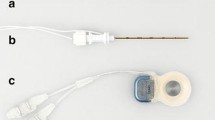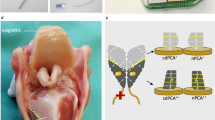Abstract
Functional electrical stimulation (FES) of the posterior cricoarytenoid muscle (PCA) to restore respiratory function of the larynx may become an option for the treatment of bilateral recurrent laryngeal nerve paralysis (RLNP) in the near future. The feasibility of this has been shown in several animal trials and in a human pilot study. The common open surgical inferolateral approach for electrode insertion into the PCA for FES has a risk of damaging the recurrent laryngeal nerve (RLN) and may result in postoperative swelling and scaring of the larynx. Therefore, a minimal invasive electrode insertion technique is needed. A new miniaturized bipolar spiral tip electrode and a new electrical stimulatable insertion needle were tested in a short-term trial for an endoscopically guided and functionally controlled transcricoidal electrode insertion in eight Göttingen minipigs with bilateral normal RLN function. The feasibility of this technique was evaluated and the achieved positions of the electrodes in the PCA were analyzed using intraoperative stimulation threshold data and 3D-CT reconstructions. In seven cases it was possible to place two well-performing electrodes into the PCA. They were positioned one on either side. In one animal no functioning electrode position could be achieved because the PCA was missed. Thresholds of the electrode tips varied between 0.2 and 2.5 mA (mean 0.71 mA). In any case maximal glottal opening could be reached before adductors were co-activated. The majority of electrodes were placed into the central lower part of the PCA with no apparent correlation between threshold and electrode position. Surgical trauma might be further reduced by using endoscopy via a laryngeal mask avoiding the temporary tracheostomy used in this trial. If the implanted electrodes remain stable in long-term tests, we suggest that this method could soon be transferred into human application.






Similar content being viewed by others
References
Zealear DL, Dedo HH (1977) Control of paralysed axial muscles by electrical stimulation. Acta Otolaryngol 83:514–527
Zealear DL, Rainey CL, Jerles ML, Tanabe T, Herzon GD (1994) Technical approach for reanimation of the chronically denervated larynx by means of functional electrical stimulation. Ann Otol Rhinol Laryngol 103:705–712
Zealear DL, Kunibe I, Nomura K, Billante C, Singh V, Huang S, Bekeny J, Choksi Y, Harabuchi Y, Katada A (2009) Rehabilitation of bilaterally paralyzed canine larynx with implantable stimulator. Laryngoscope 119:1737–1744
Bergmann K, Warzel H, Eckhardt HU, Hopstock U, Hermann V, Gerhardt HJ (1988) Long-term implantation of a system of electrical stimulation of paralyzed laryngeal muscles in dogs. Laryngoscope 98:455–459
Kano S, Sasaki CT (1991) Pacing parameters of the canine posterior cricoarytenoid muscle. Ann Otol Rhinol Laryngol 100:584–588
Zrunek M, Bigenzahn W, Mayr W, Unger E, Feldner-Busztin H (1991) A laryngeal pacemaker for inspiration-controlled, direct electrical stimulation of the denervated posterior cricoarytenoid muscle in sheep. Eur Arch Otorhinolaryngol 248:445–448
Otto RA, Templer J, Davis W, Homeyer D, Stroble M (1985) Coordinated electrical pacing of vocal cord abductors in recurrent laryngeal nerve paralysis. Otolaryngol Head Neck Surg 93:634–638
Zealear DL, Swelstad MR, Sant’Anna GD, Bannister RA, Billante CR, Rodriguez RJ, Garren KC, Billante MJ, Champney MS (2001) Determination of the optimal conditions for laryngeal pacing with the Itrel II implantable stimulator. Otolaryngol Head Neck Surg 125:183–192
Zealear DL, Billante CR, Courey MS, Netterville JL, Paniello RC, Sanders I, Herzon GD, Goding GS, Mann W, Ejnell H, Habets AM, Testerman R, Van de Heyning P (2003) Reanimation of the paralyzed human larynx with an implantable electrical stimulation device. Laryngoscope 113:1149–1156
Broniatowski M, Grundfest-Broniatowski S, Hadley AJ, Shah NS, Barbu AM, Phillipbar SA, Strohl KP, Tucker HM, Tyler DJ (2010) Improvement of respiratory compromise through abductor reinnervation and pacing in a patient with bilateral vocal fold impairment. Laryngoscope 120:76–83
National-Research-Council (2011) Guide for the care and use of laboratory animals. National Academies Press, Washington
Zealear DL, Hamdan AL, Rainey CL (1994) Effects of denervation on posterior cricoarytenoid muscle physiology and histochemistry. Ann Otol Rhinol Laryngol 103:780–788
Zealear DL, Rainey CL, Herzon GD, Netterville JL, Ossoff RH (1996) Electrical pacing of the paralyzed human larynx. Ann Otol Rhinol Laryngol 105:689–693
Goldmann K, Kalinowski M, Kraft S (2005) Airway management under general anaesthesia in pigs using the LMA-ProSeal: a pilot study. Vet Anaesth Analg 32:308–313
Acknowledgments
This work has been sponsored by Med-El Medical Electronics Innsbruck.
Conflict of interest
None.
Author information
Authors and Affiliations
Corresponding author
Rights and permissions
About this article
Cite this article
Förster, G., Arnold, D., Bischoff, S.J. et al. Laryngeal pacing in minipigs: in vivo test of a new minimal invasive transcricoidal electrode insertion method for functional electrical stimulation of the PCA. Eur Arch Otorhinolaryngol 270, 225–231 (2013). https://doi.org/10.1007/s00405-012-2141-1
Received:
Accepted:
Published:
Issue Date:
DOI: https://doi.org/10.1007/s00405-012-2141-1




